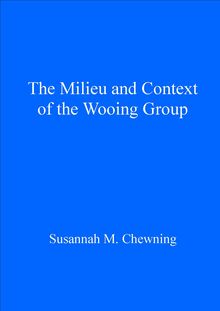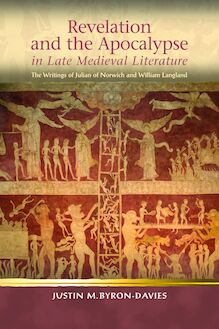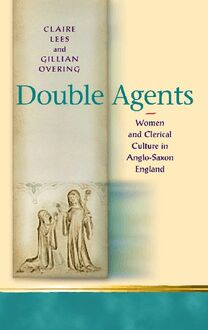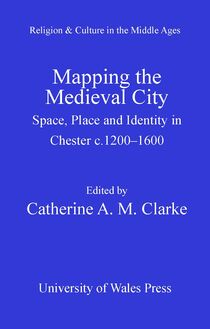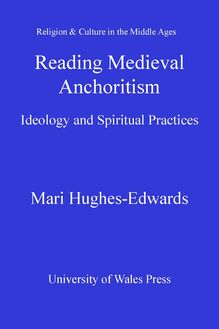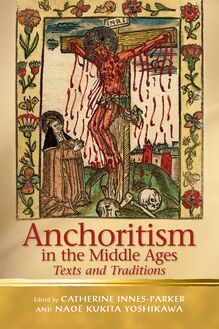-
 Univers
Univers
-
 Ebooks
Ebooks
-
 Livres audio
Livres audio
-
 Presse
Presse
-
 Podcasts
Podcasts
-
 BD
BD
-
 Documents
Documents
-
- Cours
- Révisions
- Ressources pédagogiques
- Sciences de l’éducation
- Manuels scolaires
- Langues
- Travaux de classe
- Annales de BEP
- Etudes supérieures
- Maternelle et primaire
- Fiches de lecture
- Orientation scolaire
- Méthodologie
- Corrigés de devoir
- Annales d’examens et concours
- Annales du bac
- Annales du brevet
- Rapports de stage
La lecture à portée de main
Découvre YouScribe en t'inscrivant gratuitement
Je m'inscrisDécouvre YouScribe en t'inscrivant gratuitement
Je m'inscrisEn savoir plus
En savoir plus

Description
Introduction: Medieval Chester: Views from the Walls Catherine A.M. Clarke 1. Urban mappings: Visualizing Late Medieval Chester in Cartographic and Textual Form Keith D. Lilley 2.Framing Medieval Chester: the Landscape of Urban Boundaries C.P. Lewis 3.St Werburgh's, St John's and the Liber Luciani De Laude Cestrie John Doran 4. The Spatial Hermeneutics of Lucian's De Laude Cestrie Mark Faulkner 5. '3e beoo pe ancren of Englond ... a pah 3e weren an cuuent of ... Chester': Liminal Spaces and the Anchoritic life in Medieval Chester Liz Herbert McAvoy 6.Sanctity and the City: Sacred Space in Henry Bradshaw's Life of St Werburge Laura Varnam 7.Plotting Chester on the National Map: Richard Pynson's 1521 printing of Henry Bradshaw's Life of Saint Werburge Cynthia Turner Camp 8. The Outside Within: Medieval Chester and North Wales as a Social Space Helen Fulton 9. Mapping the Migrants: Welsh, Manx and Irish Settlers in fifteenth-century Chester Jane Laughton 10.Leeks for Livery: Consuming Welsh Difference in the Chester Shepherds' Play Robert W. Barrett, Jnr 11.Remembering Anglo-Saxon Mercia in late-medieval and early-modern Chester Catherine A.M. Clarke
Sujets
Informations
| Publié par | University of Wales Press |
| Date de parution | 15 mai 2011 |
| Nombre de lectures | 0 |
| EAN13 | 9780708323939 |
| Langue | English |
| Poids de l'ouvrage | 3 Mo |
Informations légales : prix de location à la page 0,0650€. Cette information est donnée uniquement à titre indicatif conformément à la législation en vigueur.
Extrait
Religion & Culture in the Middle Ages
Mapping the
Medieval City
Space, Place and Identity in
Chester c.1200–1600
Edited by
Catherine A. M. Clarke
University of Wales PressRELIGION AND CULTURE IN THE MIDDLE AGES
Mapping the Medieval City
Mapping the Medieval City.indd 1 19/04/2011 07:17Series Editors
Denis Renevey (University of Lausanne)
Diane Watt (Aberystwyth University)
Editorial Board
Miri Rubin (Queen Mary, University of London)
Jean-Claude Schmitt (École des Hautes Études en Sciences Sociales, Paris)
Fiona Somerset (Duke University)
Christiania Whitehead (University of Warwick)
Mapping the Medieval City.indd 2 19/04/2011 07:17RELIGION AND CULTURE IN THE MIDDLE AGES
Mapping the
Medieval City
Space, Place and Identity in
Chester c.1200–1600
Edited by
CATHERINE A. M. CLARk E
UNIVERSITY OF WALES PRESS
CARDIFF
2011
Mapping the Medieval City.indd 3 19/04/2011 07:17© The Contributors, 2011
All rights reserved. No part of this book may be reproduced in any material
form (including photocopying or storing it in any medium by electronic
means and whether or not transiently or incidentally to some other use of
this publication) without the written permission of the copyright owner.
Applications for the copyright owner’s written permission to reproduce
any part of this publication should be addressed to the University of Wales
Press, 10 Columbus Walk, Brigantine Place, Cardiff, CF10 4UP.
www.uwp.co.uk
British Library Cataloguing-in-Publication Data
A catalogue record for this book is available from the British Library.
ISBN 978-0-7083-2392-2
e-ISBN 978-0-7083-2393-9
The rights of the Contributors to be identifed as authors of this work have
been asserted in accordance with sections 77 and 79 of the Copyright,
Designs and Patents Act 1988.
Printed by CPI Antony Rowe, Chippenham, Wiltshire
Mapping the Medieval City.indd 4 19/04/2011 07:17Contents
Series Editors’ Preface vii
Acknowledgements ix
Notes on Contributors xi
Abbreviations xv
Figures xvi
1 Introduction: Medieval Chester: Views from the Walls 1
Catherine A. M. Clarke
2 Urban Mappings: Visualizing Late Medieval Chester in
Cartographic and Textual Form 19
Keith D. Lilley
3 Framing Medieval Chester: the Landscape of Urban
Boundaries 42
C. P. Lewis
4 St Werburgh’s, St John’s and the Liber Luciani De Laude
Cestrie 57
John Doran
5 The Spatial Hermeneutics of Lucian’s De Laude Cestrie 78
Mark Faulkner
6 ‘3e beoð þe ancren of Englond . . . as þah 3e weren an cuuent
of … Chester’: Liminal Spaces and the Anchoritic life in
Medieval Chester 99
Liz Herbert McAvoy
Mapping the Medieval City.indd 5 19/04/2011 07:17 MAPPING THE MEDIEVAL CITY
7 Sanctity and the City: Sacred Space in Henry Bradshaw’s Life
of St Werburge 114
Laura Varnam
8 Plotting Chester on the National Map: Richard Pynson’s 1521
printing of Henry Bradshaw’s Life of St Werburge 131
Cynthia Turner Camp
9 The Outside Within: Medieval Chester and North Wales as a
Social Space 149
Helen Fulton
10 Mapping the Migrants: Welsh, Manx and Irish Settlers in
ffteenth-century Chester 169
Jane Laughton
11 Leeks for Livery: Consuming Welsh Difference in the Chester
Shepherds’ Play 184
Robert W. Barrett, Jnr
12 Remembering Anglo-Saxon Mercia in late medieval and
early modern Chester 201
Catherine A. M. Clarke
Bibliography 219
Index 235
Mapping the Medieval City.indd 6 19/04/2011 07:17series editors’ PrefaCe
Religion and Culture in the Middle Ages aims to explore the interface
between medieval religion and culture, with as broad an understanding
of those terms as possible. It puts to the forefront studies which engage
with works that signifcantly contributed to the shaping of medieval
culture. However, it also gives attention to studies dealing with works that
refect and highlight aspects of medieval culture that have been neglected
in the past by scholars of the medieval disciplines. For example,
devotional works and the practice they infer illuminate our understanding of
the medieval subject and its culture in remarkable ways, while studies of
the material space designed and inhabited by medieval subjects yield new
evidence on the period and the people who shaped it and lived in it. In
the larger feld of religion and culture, we also want to explore further the
roles played by women as authors, readers and owners of books, thereby
defning them more precisely as actors in the cultural feld. The series as a
whole investigates the European Middle Ages, from c.500 to c.1500. Our
aim is to explore medieval religion and culture with the tools belonging
to such disciplines as, among others, art history, philosophy, theology,
history, musicology, the history of medicine, and literature. In particular,
we would like to promote interdisciplinary studies, as we believe strongly
that our modern understanding of the term applies fascinatingly well to
a cultural period marked by a less tight confnement and categorization
of its disciplines than the modern period. However, our only criterion is
academic excellence, with the belief that the use of a large diversity of
critical tools and theoretical approaches enables a deeper understanding of
medieval culture. We want the series to refect this diversity, as we believe
that, as a collection of outstanding contributions, it offers a more subtle
representation of a period that is marked by paradoxes and contradictions
and which necessarily refects diversity and difference, however diffcult it
may sometimes have proved for medieval culture to accept these notions.
Mapping the Medieval City.indd 7 19/04/2011 07:17Mapping the Medieval City.indd 8 19/04/2011 07:17aCknowledgements
The essays in this volume were inspired by the Arts and Humanities
Research Council-funded interdisciplinary research project ‘Mapping
Medieval Chester: Place and Identity in an English Borderland City,
c.1200–1500’. Directed by Catherine A. M. Clarke, the project also
involved k eith Lilley and Helen Fulton as Co-Investigators and Mark
Faulkner as Post-Doctoral Researcher, together with Paul Vetch at the
Centre for Computing in the Humanities, k ing’s College London, as
Technical Director. The digital resources produced by the project can
be viewed at www.medievalchester.ac.uk. The essays by Clarke, Lilley,
Fulton and Faulkner in this collection were written as part of the
AHRCfunded research. The ‘Mapping Medieval Chester’ project also included
a major international conference at Swansea University, ‘Mapping the
Medieval City’ (July 2009). Many of the other essays in this volume were
presented as papers at this event, and indeed almost all of the volume
contributors were present at the conference, which proved a valuable
opportunity to share work in progress and exchange ideas. The volume
editor and project team would like to thank the AHRC for the funding
which enabled the ‘Mapping Medieval Chester’ research project, which
has expanded to include the collection of essays published here. Thanks
also to Gill Alexander of Queen’s University, Belfast, for drawing the
maps of medieval Chester (Figures 1 and 2) based on the digital atlas
produced by the ‘Mapping Medieval Chester’ project. The editors of the
University of Wales Press series ‘Religion and Culture in the Middle Ages’
have provided insightful and valuable comments on the various drafts of
this volume and, fnally, the volume editor would like to thank everyone at
the University of Wales Press for their expert and cheerful help, especially
the assistant commissioner Ennis Akpinar and the press’s editor Dafydd
Jones.
Mapping the Medieval City.indd 9 19/04/2011 07:17Mapping the Medieval City.indd 10 19/04/2011 07:17notes on Contributors
robert w. barrett, Jnr, is Associate Professor of English and Medieval
Studies at the University of Illinois at Urbana-Champaign. His research
crosses the period boundary between the Middle Ages and the Renaissance,
focusing on calendrical festivity, early English drama and local identity.
In addition to articles on Chester pageants and London Lord Mayor’s
Shows, his publications include the monograph Against All England:
Regional Identity and Cheshire Writing, 1195–1656 (Notre Dame, 2009).
He is currently editing the Chester Whitsun plays for the TEAMS Middle
English Texts Series and planning a second monograph on Pentecost in
early English literature.
Cynthia turner CamP is Assistant Professor of English at the University
of Georgia, where her research focuses on English hagiography, especially
ffteenth-century Middle English literature and late medieval monasticism.
She is currently preparing a monograph on the Middle English and early
Tudor lives of Anglo-Saxon saints and an edition of Henry Bradshaw’s
Life of St Werburge and Life of St Radegund.
Catherine a. m. Clarke is Senior Lecturer in English and Associate
Director of the Centre for Medieval and Early Modern Research at
Swansea University. Her research centres on earlier medieval literature
and culture, with particular attention to questions of place, power and
identity and an emphasis on interdisciplinary approaches. Her publications
include the monograph Literary Landscapes and the Idea of England,
700–1400 (Cambridge, 2006), and she was Principal Investigator on the
AHRC-funded ‘Mapping Medieval Chester’ project.
John doran is Senior Lecturer in Medieval History and programme leader
for the MA in Military History at the University of Chester. His research
focuses on the relationship between the popes and the city of Rome from
the eleventh to the thirteenth centuries, but he is also interested in the
development of Chester and its similar ecclesiastical and civic tensions.
Mapping the Medieval City.indd 11 19/04/2011 07:17 MAPPING THE MEDIEVAL CITY
His publications include an edited volume, Pope Celestine III: Diplomat
and Pastor (Ashgate: Farnham, 2009). He is currently writing a
monograph on the Popes and the City of
-
 Univers
Univers
-
 Ebooks
Ebooks
-
 Livres audio
Livres audio
-
 Presse
Presse
-
 Podcasts
Podcasts
-
 BD
BD
-
 Documents
Documents
-
Jeunesse
-
Littérature
-
Ressources professionnelles
-
Santé et bien-être
-
Savoirs
-
Education
-
Loisirs et hobbies
-
Art, musique et cinéma
-
Actualité et débat de société
-
Jeunesse
-
Littérature
-
Ressources professionnelles
-
Santé et bien-être
-
Savoirs
-
Education
-
Loisirs et hobbies
-
Art, musique et cinéma
-
Actualité et débat de société
-
Actualités
-
Lifestyle
-
Presse jeunesse
-
Presse professionnelle
-
Pratique
-
Presse sportive
-
Presse internationale
-
Culture & Médias
-
Action et Aventures
-
Science-fiction et Fantasy
-
Société
-
Jeunesse
-
Littérature
-
Ressources professionnelles
-
Santé et bien-être
-
Savoirs
-
Education
-
Loisirs et hobbies
-
Art, musique et cinéma
-
Actualité et débat de société
- Cours
- Révisions
- Ressources pédagogiques
- Sciences de l’éducation
- Manuels scolaires
- Langues
- Travaux de classe
- Annales de BEP
- Etudes supérieures
- Maternelle et primaire
- Fiches de lecture
- Orientation scolaire
- Méthodologie
- Corrigés de devoir
- Annales d’examens et concours
- Annales du bac
- Annales du brevet
- Rapports de stage
